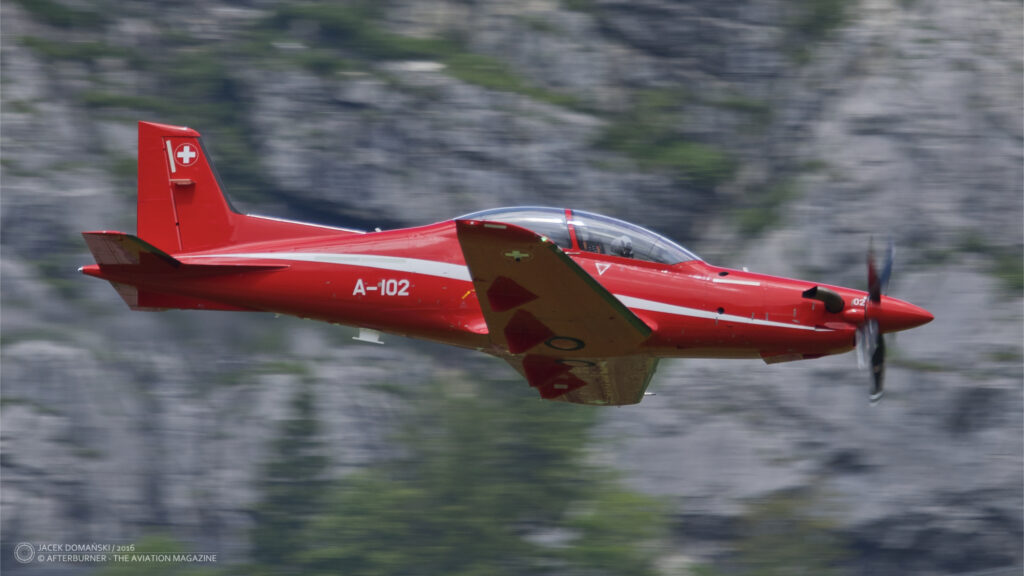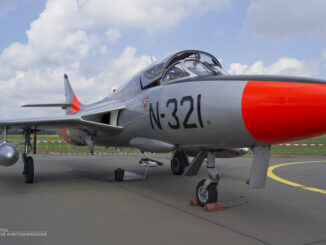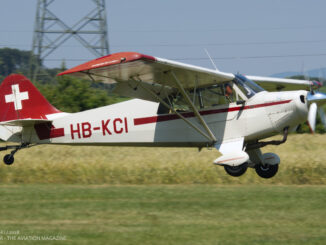 Pilatus PC-21 (c/n 104, A-102 of the Swiss Air Force), flying display at 75th Anniversary of Meiringen airfield, Meiringen, June 2016.
Pilatus PC-21 (c/n 104, A-102 of the Swiss Air Force), flying display at 75th Anniversary of Meiringen airfield, Meiringen, June 2016.
The story of training aircraft made by Pilatus company started already in the early 1940s, with the concept of a single-seat aeroplane, designated P-1. Although it remained just at a project stage and never flown, the P-1 was used as a base for the first successful trainer developed by that Swiss aviation manufacturer, the Pilatus P-2.
The P-2 performed its maiden flight in spring of 1945 and one year later began its operational service with the Swiss Air Force. In the early 1950s, the P-2 was succeeded by Pilatus P-3 – an all-metal aeroplane intended for primary and advanced training, capable of performing aerobatics, as well as night-time and instrument flights.
12th April 1966 marked beginning of an era of Pilatus turboprop trainers, with the maiden flight of PC-7. The new aircraft was developed directly from the P-3 concept, but featured new engine, bubble-shapped canopy and new wing construction. The PC-7 achieved broad commercial success and was acquired by approximately twenty air forces all over the world and built in more than six hundred examples. On 7th May 1984, an upgraded variant of that trainer, designated PC-9, performed its maiden flight.
In the late 1990s, following technological advances and latest trends in aircraft manufacturing, the Pilatus company launched a programme aiming for development of the next generation turboprop training aircraft. An aeroplane designated PC-7 Mk.II was the first stage of that initiative. Created to test new ideas and proposed improvements, the aircraft was built with use of both PC-7 and PC-9 components and performed its maiden flight at the end of 1997.
Development of the new turboprop trainer, now officially designated PC-21, had begun in January of 1999. The main goal was to create an aircraft featuring similar characteristics as jet-powered aeroplanes, allowing the PC-21 to be used as advanced training aircraft for jet pilots and therefore achieving significant savings.
Consequently, during the development of the PC-21, particular emphasis was placed on its aerobatics performance, control panels and other cockpit equipment, as well as aerodynamics. The new aircraft was designed as maintenance-friendly, with maximum flexibility allowing for adaptation of the PC-21 for a variety of training tasks. On 1st July 2002, the first prototype of the PC-21 performed its maiden flight.
The Swiss armed forces were, as usual, the first customer that acquired the new Pilatus trainer. The purchase was approved by the Swiss authorities in the late 2006 and two years later the Swiss Air Force received its first batch of four PC-21s. In December of 2010, another order for two more aircraft was placed.
In 2006, the first export sale contract was concluded, covering delivery of nineteen aircraft for Singapore Air Force. Then, the PC-21 was purchased by the United Arab Emirates, Qatar, Saudi Arabia, Australia, Jordania and France. Finally, there was a Spanish sale contract, signed in the early 2020. In addition, the PC-21 was recently evaluated by Belgian Air Component.
The aircraft A-102 pictured above, is the first serial PC-21 produced for the Swiss Air Force. The aeroplane performed its maiden flight on 6th July 2007.



